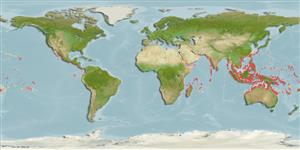>
Eupercaria/misc (Various families in series Eupercaria) >
Haemulidae (Grunts) > Plectorhinchinae
Etymology: Plectorhinchus: Greek, plektos = plaited + Greek, rhyngchos = snout (Ref. 45335).
More on author: Lacepède.
Environment: milieu / climate zone / depth range / distribution range
Ecología
marino; agua dulce; salobre asociado a arrecife; rango de profundidad 8 - 25 m (Ref. 58652). Tropical; 30°N - 24°S
Indo-West Pacific: Red Sea to Natal, South Africa (including Madagascar and the Comoro and Reunion islands); Gulf of Aden and the Persian Gulf eastward to Samoa, north to the Ryukyu Islands, south to Australia; Caroline and Mariana islands in Micronesia.
Tamaño / Peso / Age
Maturity: Lm ? range ? - ? cm
Max length : 75.0 cm TL macho / no sexado; (Ref. 30874)
Espinas dorsales (total): 14; Radios blandos dorsales (total): 15-16; Espinas anales 3; Radios blandos anales: 7 - 8.
Found in coastal reefs, sandbanks, and near estuaries (Ref. 30573). Enter freshwater (Ref. 7050). Small juveniles occur along sheltered sandy shorelines where they mimic a dead leaf by drifting on their sides (Ref. 37816). Adults mainly in protected inshore reefs to deep offshore, sometimes swims in small groups (Ref. 48635). Excellent food fish (Ref. 2799).
Life cycle and mating behavior
Madurez | Reproducción | Puesta | Huevos | Fecundidad | Larva
Oviparous, distinct pairing during breeding (Ref. 205).
Myers, R.F., 1991. Micronesian reef fishes. Second Ed. Coral Graphics, Barrigada, Guam. 298 p. (Ref. 1602)
IUCN Red List Status (Ref. 130435)
Threat to humans
Reports of ciguatera poisoning (Ref. 2799)
Human uses
Pesquerías: comercial; pesca deportiva: si
Más información
ReferenciasAcuiculturaPerfil de acuiculturaRazasGenéticaElectrophoresesheritabilidadEnfermedadesProcesamientoNutrientsMass conversion
ColaboradoresImágenesStamps, Coins Misc.SonidosCiguateraVelocidadTipo de nataciónSuperficie branquialOtolitosCerebrosVisión
Herramientas
Special reports
Download XML
Fuentes de Internet
Estimates based on models
Preferred temperature (Ref.
123201): 25.2 - 29.3, mean 28.4 °C (based on 3703 cells).
Phylogenetic diversity index (Ref.
82804): PD
50 = 0.5000 [Uniqueness, from 0.5 = low to 2.0 = high].
Bayesian length-weight: a=0.01995 (0.01110 - 0.03588), b=2.93 (2.77 - 3.09), in cm total length, based on LWR estimates for this species & (Sub)family-body (Ref.
93245).
Nivel trófico (Ref.
69278): 3.6 ±0.5 se; based on diet studies.
Generation time: 5.5 ( na - na) years. Estimated as median ln(3)/K based on 1
growth studies.
Resiliencia (Ref.
120179): Medio, población duplicada en un tiempo mínimo de 1.4-4.4 años (K=0.20).
Fishing Vulnerability (Ref.
59153): Moderate to high vulnerability (45 of 100).
Nutrients (Ref.
124155): Calcium = 24.5 [11.3, 52.9] mg/100g; Iron = 0.465 [0.242, 0.872] mg/100g; Protein = 19.3 [17.4, 21.3] %; Omega3 = 0.0948 [, ] g/100g; Selenium = 32.7 [16.9, 62.6] μg/100g; VitaminA = 37.4 [10.8, 128.7] μg/100g; Zinc = 0.981 [0.633, 1.547] mg/100g (wet weight);
